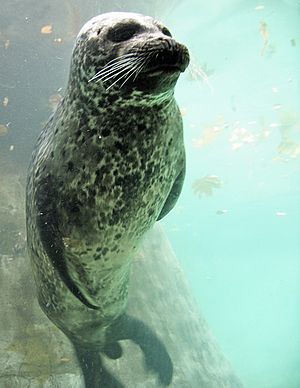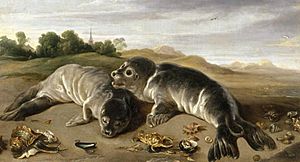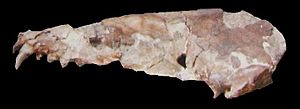Earless seal facts for kids
Quick facts for kids Earless seal |
|
|---|---|
 |
|
| A Common Seal (Phoca vitulina) | |
| Scientific classification | |
| Kingdom: | |
| Phylum: | |
| Class: | |
| Order: | |
| Suborder: | |
| Superfamily: | |
| Family: |
Phocidae
Gray, 1821
|
The earless seals, phocids or true seals are one of the three main groups of mammals within the seal lineage, Pinnipedia. All true seals are members of the family Phocidae. They are sometimes called crawling seals to distinguish them from the fur seals and sea lions of the family Otariidae. Seals live in the oceans of both hemispheres and, with the exception of the more tropical monk seals, are mostly confined to polar, subpolar, and temperate climates. The Baikal seal is the only species of exclusively freshwater seal.
Contents
Evolution
The earliest known fossil earless seal is Noriphoca gaudini from the late Oligocene or earliest Miocene (Aquitanian) of Italy. Other early fossil phocids date from the mid-Miocene, 15 million years ago in the north Atlantic. Until recently, many researchers believed that phocids evolved separately from otariids and odobenids; and that they evolved from otter-like animals, such as Potamotherium, which inhabited European freshwater lakes. Recent evidence strongly suggests a monophyletic origin for all pinnipeds from a single ancestor, possibly Enaliarctos, most closely related to the mustelids and bears.
Monk seals and elephant seals were previously believed to have first entered the Pacific through the open straits between North and South America, with the Antarctic true seals either using the same route or travelled down the west coast of Africa. It is now thought that the monk seals, elephant seals, and Antarctic seals all evolved in the southern hemisphere, and likely dispersed to their current distributions from more southern latitudes.
Taxonomy
- Family Phocidae
- Subfamily Monachinae
- Tribe Monachini
- Genus Monachus
- Mediterranean Monk Seal (Monachus monachus)
- Hawaiian Monk Seal (Monachus schauinslandi)
- Caribbean Monk Seal (Monachus tropicalis) †
- Genus Mirounga: Elephant seals
- Northern Elephant Seal (Mirounga angustirostris)
- Southern Elephant Seal (Mirounga leonina)
- Genus Monachus
- Tribe Lobodontini
- Genus Ommatophoca
- Ross Seal (Ommatophoca rossii)
- Genus Lobodon
- Crabeater Seal (Lobodon carcinophagus)
- Genus Hydrurga
- Leopard Seal (Hydrurga leptonyx)
- Genus Leptonychotes
- Weddell Seal (Leptonychotes weddellii)
- Genus Ommatophoca
- Tribe Monachini
- Subfamily Phocinae
- Genus Cystophora
- Hooded Seal (Cystophora cristata)
- Genus Erignathus
- Bearded Seal (Erignathus barbatus)
- Genus Histriophoca
- Ribbon Seal (Histriophoca fasciata)
- Genus Phoca
- Spotted Seal (Phoca largha)
- Common Seal or Harbor Seal (Phoca vitulina)
- Harp Seal (Phoca groenlandica, formerly Pagophilus groenlandicus)
- Genus Pusa
- Ringed Seal (Pusa hispida, formerly Phoca hispida)
- Caspian Seal (Pusa caspica, formerly Phoca caspica)
- Nerpa or Baikal Seal (Pusa sibirica, formerly Phoca sibirica)
- Genus Halichoerus
- Grey Seal (Halichoerus grypus)
- Genus Cystophora
- Subfamily Monachinae
Images for kids
-
Harbor seal skull (Phoca vitulina)
-
Living only in Lake Saimaa, Finland, Saimaa ringed seals, a subspecies of ringed seal, are among the most endangered seals in the world, having a total population of only about 400 individuals.
See also
 In Spanish: Foca para niños
In Spanish: Foca para niños








